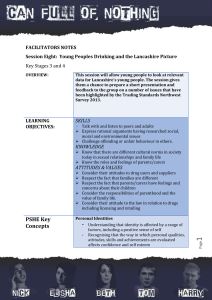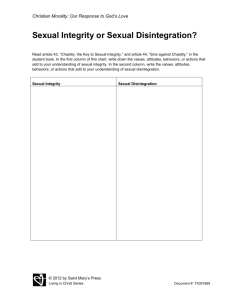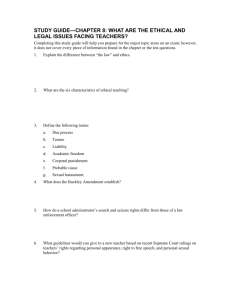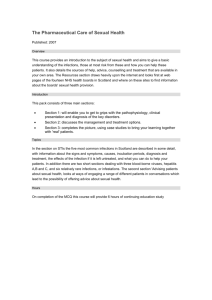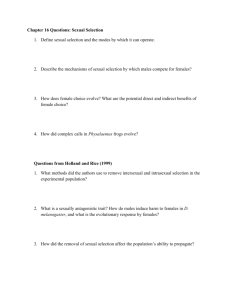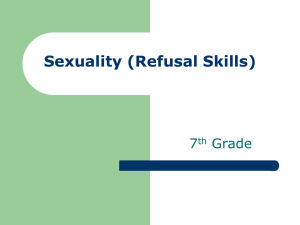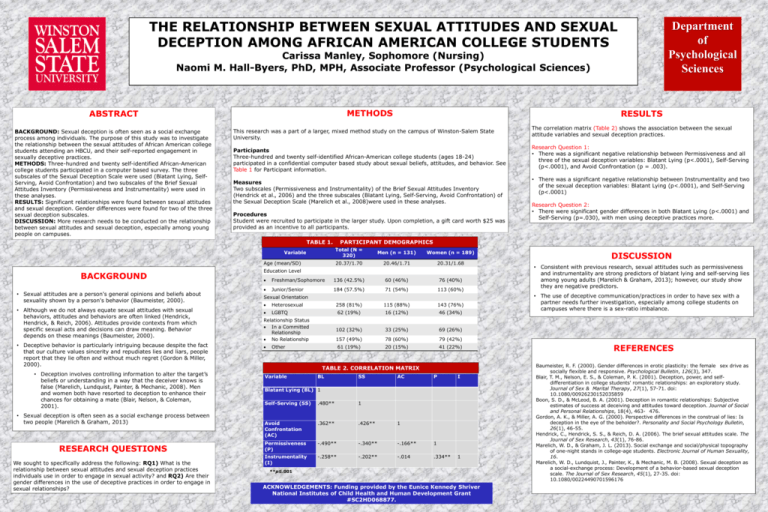
THE RELATIONSHIP BETWEEN SEXUAL ATTITUDES AND SEXUAL
DECEPTION AMONG AFRICAN AMERICAN COLLEGE STUDENTS
Department
of
Psychological
Sciences
Carissa Manley, Sophomore (Nursing)
Naomi M. Hall-Byers, PhD, MPH, Associate Professor (Psychological Sciences)
METHODS
ABSTRACT
BACKGROUND: Sexual deception is often seen as a social exchange
process among individuals. The purpose of this study was to investigate
the relationship between the sexual attitudes of African American college
students attending an HBCU, and their self-reported engagement in
sexually deceptive practices.
METHODS: Three-hundred and twenty self-identified African-American
college students participated in a computer based survey. The three
subscales of the Sexual Deception Scale were used (Blatant Lying, SelfServing, Avoid Confrontation) and two subscales of the Brief Sexual
Attitudes Inventory (Permissiveness and Instrumentality) were used in
these analyses.
RESULTS: Significant relationships were found between sexual attitudes
and sexual deception. Gender differences were found for two of the three
sexual deception subscales.
DISCUSSION: More research needs to be conducted on the relationship
between sexual attitudes and sexual deception, especially among young
people on campuses.
This research was a part of a larger, mixed method study on the campus of Winston-Salem State
University.
Participants
Three-hundred and twenty self-identified African-American college students (ages 18-24)
participated in a confidential computer based study about sexual beliefs, attitudes, and behavior. See
Table 1 for Participant information.
Measures
Two subscales (Permissiveness and Instrumentality) of the Brief Sexual Attitudes Inventory
(Hendrick et al., 2006) and the three subscales (Blatant Lying, Self-Serving, Avoid Confrontation) of
the Sexual Deception Scale (Marelich et al., 2008)were used in these analyses.
Procedures
Student were recruited to participate in the larger study. Upon completion, a gift card worth $25 was
provided as an incentive to all participants.
TABLE 1.
Age (mean/SD)
• Sexual attitudes are a person's general opinions and beliefs about
sexuality shown by a person's behavior (Baumeister, 2000).
• Although we do not always equate sexual attitudes with sexual
behaviors, attitudes and behaviors are often linked (Hendrick,
Hendrick, & Reich, 2006). Attitudes provide contexts from which
specific sexual acts and decisions can draw meaning. Behavior
depends on these meanings (Baumeister, 2000).
• Deceptive behavior is particularly intriguing because despite the fact
that our culture values sincerity and repudiates lies and liars, people
report that they lie often and without much regret (Gordon & Miller,
2000).
• Deception involves controlling information to alter the target’s
beliefs or understanding in a way that the deceiver knows is
false (Marelich, Lundquist, Painter, & Mechanic, 2008). Men
and women both have resorted to deception to enhance their
chances for obtaining a mate (Blair, Nelson, & Coleman,
2001).
• Sexual deception is often seen as a social exchange process between
two people (Marelich & Graham, 2013)
RESEARCH QUESTIONS
We sought to specifically address the following: RQ1) What is the
relationship between sexual attitudes and sexual deception practices
individuals use in order to engage in sexual activity? and RQ2) Are their
gender differences in the use of deceptive practices in order to engage in
sexual relationships?
Total (N =
320)
Men (n = 131)
Women (n = 189)
20.37/1.70
20.46/1.71
20.31/1.68
Education Level
•
Freshman/Sophomore
136 (42.5%)
60 (46%)
76 (40%)
•
Junior/Senior
184 (57.5%)
71 (54%)
113 (60%)
258 (81%)
115 (88%)
143 (76%)
62 (19%)
16 (12%)
46 (34%)
102 (32%)
33 (25%)
69 (26%)
157 (49%)
78 (60%)
79 (42%)
61 (19%)
20 (15%)
41 (22%)
Sexual Orientation
•
Heterosexual
•
LGBTQ
Relationship Status
• In a Committed
Relationship
• No Relationship
•
Other
TABLE 2. CORRELATION MATRIX
Variable
The correlation matrix (Table 2) shows the association between the sexual
attitude variables and sexual deception practices.
Research Question 1:
• There was a significant negative relationship between Permissiveness and all
three of the sexual deception variables: Blatant Lying (p<.0001), Self-Serving
(p<.0001), and Avoid Confrontation (p = .003).
• There was a significant negative relationship between Instrumentality and two
of the sexual deception variables: Blatant Lying (p<.0001), and Self-Serving
(p<.0001)
Research Question 2:
• There were significant gender differences in both Blatant Lying (p<.0001) and
Self-Serving (p=.030), with men using deceptive practices more.
PARTICIPANT DEMOGRAPHICS
Variable
BACKGROUND
RESULTS
BL
SS
AC
P
I
Blatant Lying (BL) 1
Self-Serving (SS)
.480**
1
Avoid
Confrontation
(AC)
.362**
.426**
1
Permissiveness
(P)
-.490**
-.340**
-.166**
1
Instrumentality
(I)
-.258**
-.202**
-.014
.334**
1
**p≤.001
ACKNOWLEDGEMENTS: Funding provided by the Eunice Kennedy Shriver
National Institutes of Child Health and Human Development Grant
#SC2HD068877.
DISCUSSION
• Consistent with previous research, sexual attitudes such as permissiveness
and instrumentality are strong predictors of blatant lying and self-serving lies
among young adults (Marelich & Graham, 2013); however, our study show
they are negative predictors.
• The use of deceptive communication/practices in order to have sex with a
partner needs further investigation, especially among college students on
campuses where there is a sex-ratio imbalance.
REFERENCES
Baumeister, R. F. (2000). Gender differences in erotic plasticity: the female sex drive as
socially flexible and responsive. Psychological Bulletin, 126(3), 347.
Blair, T. M., Nelson, E. S., & Coleman, P. K. (2001). Deception, power, and selfdifferentiation in college students' romantic relationships: an exploratory study.
Journal of Sex & Marital Therapy, 27(1), 57-71. doi:
10.1080/00926230152035859
Boon, S. D., & McLeod, B. A. (2001). Deception in romantic relationships: Subjective
estimates of success at deceiving and attitudes toward deception. Journal of Social
and Personal Relationships, 18(4), 463- 476.
Gordon, A. K., & Miller, A. G. (2000). Perspective differences in the construal of lies: Is
deception in the eye of the beholder?. Personality and Social Psychology Bulletin,
26(1), 46-55.
Hendrick, C., Hendrick, S. S., & Reich, D. A. (2006). The brief sexual attitudes scale. The
Journal of Sex Research, 43(1), 76-86.
Marelich, W. D., & Graham, J. L. (2013). Social exchange and social/physical topography
of one-night stands in college-age students. Electronic Journal of Human Sexuality,
16.
Marelich, W. D., Lundquist, J., Painter, K., & Mechanic, M. B. (2008). Sexual deception as
a social-exchange process: Development of a behavior-based sexual deception
scale. The Journal of Sex Research, 45(1), 27-35. doi:
10.1080/00224490701596176


